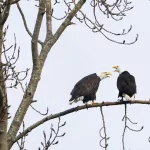(AP) – The Trump administration plans to eliminate habitat protections for endangered and threatened species in a move environmentalists say would lead to the extinction of critically endangered species because of logging, mining, development and other activities.
At issue is a long-standing definition of “harm” in the Endangered Species Act, which has included altering or destroying the places those species live. Habitat destruction is the biggest cause of extinction, said Noah Greenwald, endangered species director at the Center for Biological Diversity.
The U.S. Fish and Wildlife Service and National Marine Fisheries Service said in a proposed rule issued Wednesday that habitat modification should not be considered harm because it is not the same as intentionally targeting a species, called “take.” Environmentalists argue that the definition of “take,” though, has always included actions that harm species, and the definition of “harm” has been upheld by the U.S. Supreme Court.
The proposed rule “cuts the heart out of the Endangered Species Act,” Greenwald said. “If (you) say harm doesn’t mean significant habitat degradation or modification, then it really leaves endangered species out in the cold.”
For example, he said spotted owls and Florida panthers both are protected because the current rule forbids habitat destruction. But if the new rule is adopted, someone who logs in a forest or builds a development would be unimpeded as long as they could say they didn’t intend to harm an endangered species, he said.
The proposed rule was expected to be published in the Federal Register on Thursday, kicking off a 30-day public comment period.
A U.S. Fish and Wildlife Service spokeswoman referred The Associated Press to the Department of Interior, which declined to comment.
Environmental groups will challenge the rule in court if it is adopted, said Drew Caputo, an attorney at Earthjustice.
He said the proposal “threatens a half-century of progress in protecting and restoring endangered species,” including bald eagles, gray wolves, Florida manatees and humpback whales. He said that is because the current rule “recognizes the common-sense concept that destroying a forest, beach, river, or wetland that a species relies on for survival constitutes harm to that species.”
The question is whether the Trump administration is entitled to repeal a rule that was upheld specifically by the Supreme Court and therefore subject to precedent, said Patrick Parenteau, an emeritus professor at the Vermont Law and Graduate School who has handled endangered species cases.
Because of the current definition of harm, “many, many millions of acres of land has been conserved” to help keep species alive, he said.
The issue is of particular concern in Hawaii. The islands have more endangered species than any other state — 40% of the nation’s federally listed threatened and endangered species — even though Hawaii has less than 1% of the land area, according to the National Fish and Wildlife Foundation.
Maxx Philipps, Hawaii and Pacific Islands director for the Center for Biological Diversity, said removing these safeguards will accelerate Hawaii’s extinction crisis and erode the biological and cultural heritage of the islands.
She pointed to the example of tiny native bees that forage on and pollinate coastal dune plants. Very little oceanfront property remains undeveloped and what is left tends to be fragmented pockets. Other listed species living on the shoreline — like green sea turtles –- could also lose their homes if protections are removed.
“Habitat is life, right?” she said. “And without it, there is no recovery and without recovery, there is only extinction.”
© copyright 2025 Associated Press. All rights reserved
AP Photo
